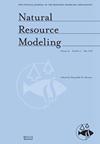Editorial
IF 2.1
4区 环境科学与生态学
Q3 ENVIRONMENTAL SCIENCES
引用次数: 0
Abstract
Since 1995, the Resource Modeling Association (RMA) has organized the World Conference on Natural Resource Modeling (WCNRM), an annual meeting that brings together scientists, stakeholders and students interested in the mathematical modeling of renewable and exhaustible resources. For the first time in South America, and just before the pandemic began, WCNRM was held in January 2020 in Valparaíso, Chile, organized by the Universidad Técnica Federico Santa María and the Universidad de Chile. Participants from 20 countries presented novelties on different topics related to natural resources and specifically on the conference theme: “Decision support methods for natural systems at risk.” This special issue collects a selection of papers and ideas presented during WCNRM 2020. Topics covered in this collection include: A modeling approach for evaluating the interplay between global warming and body size in fish stocks, providing important messages to mid‐ and long‐term if current temperature trends continue; A probabilistic model for detecting locations at risk from human‐ transported pathogens, methodology that can be applied to a wide class of problems, and it is illustrated with a very nice example on the sudden oak death; A crop choice model for estimating future returns from the irrigated land under different scenarios, concluding that financial and technical assistant to farmers for conserving groundwater would be sustainable and efficient from a cost–benefit viewpoint, conclusion obtained from a case study on the Mississippi River Alluvial Aquifer; A dynamical model for a terrestrial ecosystem whose analysis shows how biodiversity conservation can reduce infectious diseases; A generalization of a multivariate spatial variables methodology to provide a common effective sample size when all variables have been measured at the same locations, with concrete applications such as a soil contamination data set; A quantitative analysis of an epidemiological model of HIV/AIDS using Bayesian inference, for which the basic reproductive number was estimated based on the estimation of the model parameters; And the characterization of the set of robust sustainable thresholds for a discrete‐time controlled dynamic system, which provides useful information to users and decision‐makers as it illustrates the trade‐offs between the achievement of different objectives in fishery management. We would like to thank the authors who submitted their papers to this special issue and all the reviewers for their invaluable job during these unusual pandemic times. We are also indebted to the Editor‐in‐Chief, Shandelle Henson, for her support during the whole process.编辑
自1995年以来,资源建模协会(RMA)组织了世界自然资源建模会议(WCNRM),这是一个一年一度的会议,汇集了对可再生资源和可耗尽资源的数学建模感兴趣的科学家,利益相关者和学生。2020年1月,在大流行开始之前,南美洲第一次在智利Valparaíso举行了由智利大学María和智利大学组织的WCNRM。来自20个国家的与会者介绍了与自然资源有关的不同主题的新奇事物,特别是会议主题:“处于危险中的自然系统的决策支持方法”。本期特刊收集了WCNRM 2020期间提出的一些论文和想法。本系列涵盖的主题包括:评估全球变暖和鱼类种群体型之间相互作用的建模方法,如果目前的温度趋势继续下去,将为中长期提供重要信息;一个概率模型,用于检测人类传播病原体的危险地点,这种方法可以应用于广泛的问题,并以橡树猝死的一个很好的例子来说明;建立了一种作物选择模型,用于估算不同情景下灌溉土地的未来收益,从成本效益的角度得出结论,认为向农民提供保护地下水的财政和技术援助将是可持续和有效的,结论来自密西西比河冲积含水层的案例研究;陆地生态系统动力学模型,其分析显示生物多样性保护如何能够减少传染病;推广多元空间变量方法,当所有变量在同一地点测量时,提供一个共同的有效样本量,具体应用如土壤污染数据集;利用贝叶斯推理方法对HIV/AIDS流行病学模型进行定量分析,根据模型参数估计基本生殖数。以及离散时间控制动态系统的鲁棒可持续阈值集的特征,它为用户和决策者提供了有用的信息,因为它说明了在渔业管理中实现不同目标之间的权衡。我们要感谢向本期特刊投稿的作者和所有审稿人,感谢他们在这一不寻常的大流行时期所做的宝贵工作。我们也感谢总编辑Shandelle Henson在整个过程中的支持。
本文章由计算机程序翻译,如有差异,请以英文原文为准。
求助全文
约1分钟内获得全文
求助全文
来源期刊

Natural Resource Modeling
环境科学-环境科学
CiteScore
3.50
自引率
6.20%
发文量
28
审稿时长
>36 weeks
期刊介绍:
Natural Resource Modeling is an international journal devoted to mathematical modeling of natural resource systems. It reflects the conceptual and methodological core that is common to model building throughout disciplines including such fields as forestry, fisheries, economics and ecology. This core draws upon the analytical and methodological apparatus of mathematics, statistics, and scientific computing.
 求助内容:
求助内容: 应助结果提醒方式:
应助结果提醒方式:


